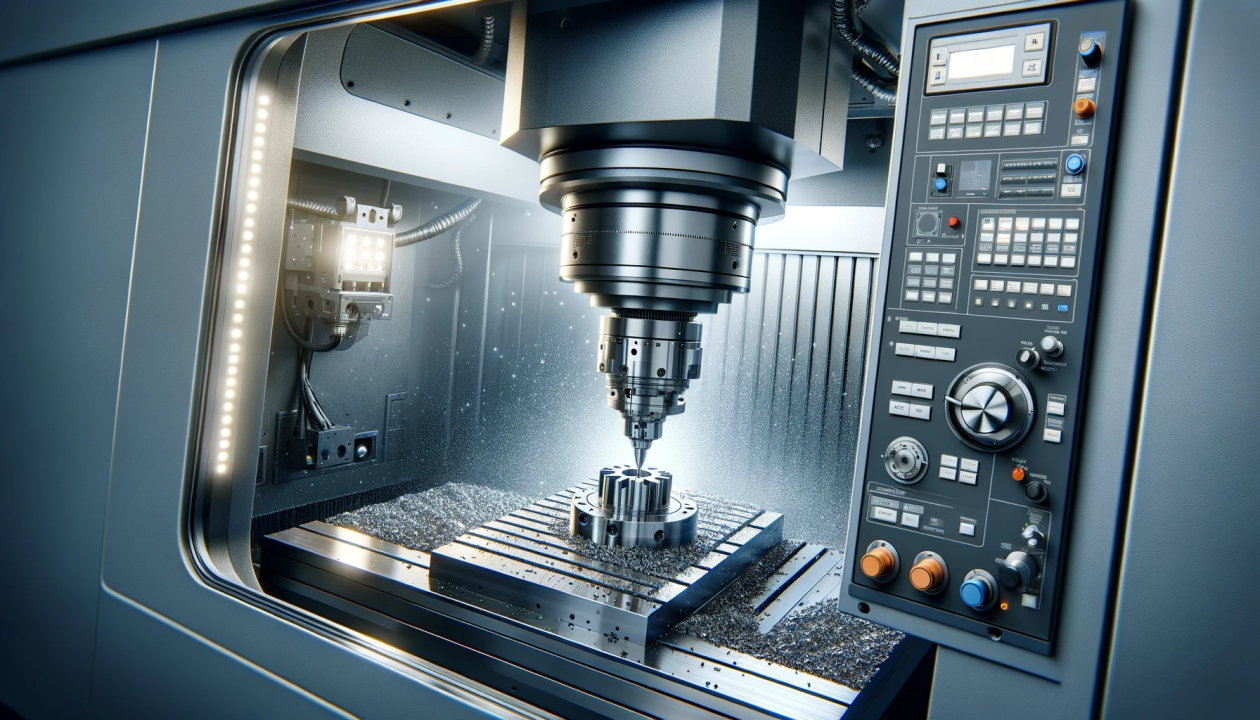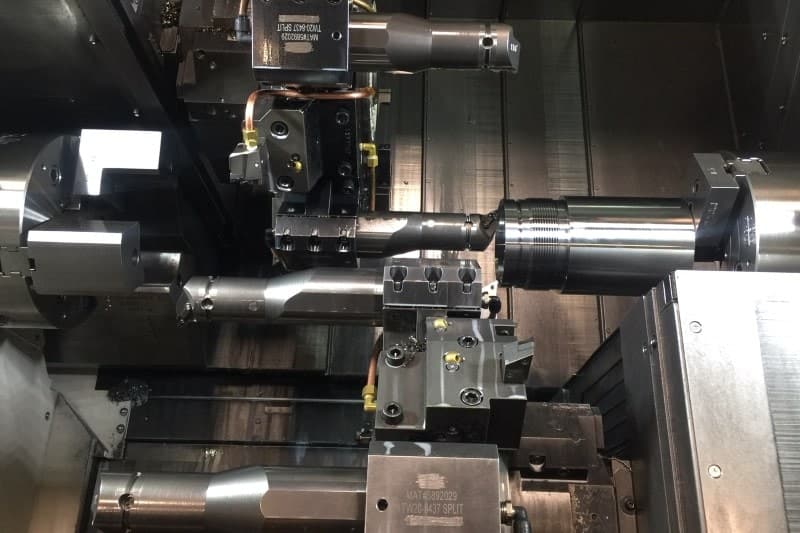Innovative CNC engraving technologies include laser-assisted engraving for increased speed, ultrasonic vibration to reduce tool wear, and adaptive control technology for enhanced precision.
Laser-Assisted Engraving
Laser-assisted engraving is the use of laser technology to preheat the material surface before traditional CNC precision mechanical machining. A laser beam heats the material to a critical temperature for effective engraving without subsequently removing material, reducing tool wear and improving the finish quality. Generally, the complex process is highly controlled by CAD/CAM systems and equipped with supporting laser technology. It can be used for both very hard metals such as titanium and softer materials like plastics. It is possible because when the surface is softened, it can be more easily removed by conventional machining.
Technical Specifications and Performance
The engraving is usually done using Nd:YAG or fiber lasers, known for relatively high energy efficiency and ability to focus on a very small area, to as much as 0.002 inches. Therefore the process is suitable for very fine detailing, which can be essential for some applications where micro-precision is needed. The intensity of the laser and the exposure time are highly controlled to match the properties of the material being engraved, with specially developed regimes for lower damage to the material as well as achieving optimal depth.
Material Compatibility
The process is highly versatile in terms of compatible materials. It is especially effective on metals such as stainless steel, aluminum, and precious metals, as the laser can soften the surface and make the mechanical engraving process after that smoother and faster. It is also used for electronic components, where mechanical machining would be too rough, and jewelry, where precision is needed without weakening the material itself.
Industrial Applications
The aerospace industry uses the technology to engrave titanium components with unique number identifiers that can withstand the harsh weather. In the automotive industry, the method is used to engrave durable and precise labels on dozens of different parts that can then withstand extreme conditions. Finally, the tech industry uses it for extremely fine and accurate engravings for making microchips and PCBs where even traditional chemical engraving would be too imprecise or harmful for the components.

Micro Milling Technology
Micro milling technology is a significant development in CNC engraving that allows the use of extremely fine details on a micro scale. This method uses miniature cutting tools to remove amounts of materials that are very small. The technique uses tools with diameters ranging from 0.1mm to 1mm. The most significant advantage of micro milling is that it cuts extremely fine features of materials. Therefore, this method is very useful in the electronics industry, microfluidic applications, and manufacturing medical implants.
Technical Aspects and Capabilities
High precision linear guides and the ability to rotate the spindle up to 100,000 RPM technology of micro-milling machines reduce vibration and guarantee machining that is smoother and faster, providing a higher surface finish. Moreover, precision tolerances as little as ± 1 micron achieve manufacturing precision of semiconductor parts and precision molds. Furthermore, micro milling technology is also equipped with revolutionary software that interprets CAD designs and then executes the precise order to guarantee even the most complex geometry is flawlessly reproduced.
Materials Suitable For Micro Milling
Micro milling technology can be applied to a variety of materials. These include different metals which encompass steel, cast iron, aluminum, cobalt chrome, magnesium, brass, copper, and titanium materials. Furthermore, micro milling can equally be materialized on polymers such as ABS, polycarbonate, and other polymers. Additionally, there are composite materials that are also compatible with micro milling. Each material has an impact on the tooling and the milling operations. Harsher materials, for instance, require slower spindle speeds and feed rates to maintain accuracy without greatly contributing to tool wear. For each type of material, a specific tool is used to ensure the highest possible precision.
Applications in Industry
In the medical industry, micro milling is used to manufacture products characterized by complex features that cannot be achieved by traditional CNC machines due o their sizr. Dental implants are some of the devices used in the medical industry whose micro components are manufactured using micro milling technology. The individual’s comfort largely depends on the precision of the dental implants. In the electronics industry, however, micro milling has been applied in producing smartphone components which are generated from micro-molds.
Challenges and Innovations
One of the significant challenges of micromilling is the tool wear associated with the technique. Tools wear faster because the using an end mill with a diameter about 100 times smaller than that of a traditional milling end mill is considered to be a high level of precision. The tool needs to move so close to the material (sic) to cut it even a little. This issue has resulted in high costs of tool replacement. However, advances in coating technologies of the tools have significantly reduced tool wear. Furthermore, there has been the introduction of new tools with important coatings. Diamond-like carbon coatings, for example, have caused an improvement in tool life. On the other hand, thermal stability has posed another challenge to micro milling thereby calling for the use of temperature-controlled environments to facilitate the stability of the material and to achieve consistent results.
Ultrasonic Vibration Engraving
Ultrasonic Vibration Engraving is the technology of utilizing high-frequency ultrasonic vibrations to improve CNC engraving. The procedure refers to the assignment of an ultrasonic frequency, typically around 20 kHz and 40 kHz, to the engraving tools, leading to small oscillations which facilitate exact material removal. The technology is advantageous when dealing with hard materials, like ceramics and hardened steels Persian where traditional CNC engraving is efficient.
Measures and Mechanisms
vibration engraving machines are equipped with a piezoelectric transducer which is responsible for transmitting the applied electrical signals into mechanical vibrations. The vibrations are implemented to the cutting tool, which is, therefore, allowed to oscillate ultrasonically. The frequency of the oscillation, i.e., the amplitude in such a case can be precisely specified, it is typically in the proximity of 1 to 10 microns, and controls the outcomes of the process operation. The engraving exhibits reduced force and minimization of the tool with cutting surfaces, therefore lowering the resultant wear of the cutting tools.
Material Effects and Importance
Ultrasonic Vibration Engraving is particularly relevant because it fails to produce chips while in operation, and this improves the overall compatibility with a wide variety of work materials. The procedure is efficient for development with metals as well as brittle materials, such as ceramics and glass. Cognitive engraving failure to exhibit vibration leads to escalated risks of fractures and chipping. In both circumstances, UVE is responsible for creating a smoother product finish and improved aesthetics.
Electrochemical Etching
Electrochemical Etching, or the Electrochemical Machining process , is the type of CNC engraving that relies on the use of electric currents to remove excess material from a conductive workpiece. From the point of view of efficiency, it is one of the best methods to engrave or otherwise process pieces of work.
Technical Characteristics and Mechanics
The tool in the electromachining process becomes the cathode, whereas the workpiece acts as the anode. An electrolyte solution flows between the two while the controlled electric charge is applied t the system. This facilitates the migration of metal ions from the anode to the electrolyte, thus etching the workpiece along the designated path. The process allows for the workpiece to be etched at the depths from 0.1 to several millimeters with the precision level of up to ±0.005 mm depending on the specifics of the ECM system designed.
Suitable Materials and the Advantages of Technology
Any conducting material can be etched with an electrochemical etching machine, including hardened steels, titanium, as well as superalloys like Inconel. In particular, the metalworking process is particularly useful for creating design elements that would require high levels of tool wear and intricately devised tool paths. The nature of the process ensures that the material is not contacted during the machining, meaning that no mechanical force is applied. This, in turn, implies that the process is completely stress-free and can be used to etch extremely thin and intricate parts of designs.
Examples of the Technology Use
The aerospace and medical industries are the primary adopters of ECM technology, especially in the creation of turbine blades that require the most accurate engraving works. No other technology is capable of providing a non-contact and burr-free process with a minimum level of machined surfaces. The medical sector uses ECM to create design elements such as implants that need to have an extremely high level of geometrical complexity.
Recently, the only consistent challenge with the use of technology has been the unpredicted shape of the etched area, which often spreads further than the initial target. The innovations in the last decade have targeted this issue, introducing a new, more controllable electrolyte into the mix. Additionally, the advances in CAD/CAM design have also made the predicting increasingly better.

3D Relief Engraving
3D Relief Engraving is a CNC technique in which intricate, three-dimensional patterns are carved into various materials to produce a lifelike, tactile effect. It is performed by sophisticated CNC routers with multi-axis movements to recreate various curves, shapes, and angles. By means of 3D relief engraving, workers can closely replicate the appearance of real-life items with remarkable detail.
Specification and mechanism of 3D relief engraving
3D relief engraving requires multiple passes of the CNC with the cutting tool. The tool forms an engraving while moving along the programmed trajectory. Diameter: typical tools used might be ball nose end mills that can leave a smooth contour and features as small as 0.01mm. Material is gradually being removed as the process is repeated in several passes. The machines used have an accuracy of 0.1 mm and higher to avoid any unevenness on the detailed sculptures.
Compatibility of materials and advantages of 3D relief engraving:
The method works well on various materials: wood, metals, or synthetic resins. However, wood is the most popular one in 3D relief engraving, regardless of its hardness. It is preferred for being easy to work with and applied after 3D-relief engraving. The results desired are usually stained or painted in a variety of shades or left uncolored. Benefits include the production of costly museum-quality sculptures and decorative panels, which are highly demanded in woodworking and luxury industry.
Industrial uses :
In the art and decoration industry, 3D-relief engraving is used to create works of art out of ordinary materials. These resultant products are wooden decorative panels used for luxury home interiors, specifically-sought themes, and patterns.
Emerging applications and future developments:
The latest development is the increasing precision of the tool’s trajectory thanks to the new CNC software. The critical part is to distribute the tool paths, so that as little material would be wasted as possible and that no material would be distorted or damaged while engraving. Prior to the actual cutting, simulations of the process could be run. Thus, the mistakes could be eliminated, and the best quality would be ensured.








